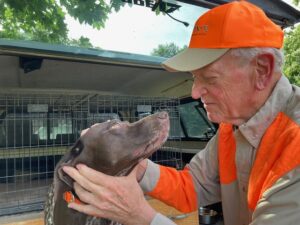Mean Seeds

By Paul Fuller
The prairies are calling. I believe it was Bing Crosby who gave us this lyric: Home, home on the range, where the deer and antelope play. I’ve been getting many inquires recently about hunting the prairies. I’ve written many times about hunting the prairies in this column, however, one issue I haven’t covered is mean seeds. This is very important and something every bird dog owner hunting the prairies needs to be aware of.
Grass Can Kill
Mean seeds are a grass that can kill your dog. You may think I’m referring to your dogs eating a toxic grass. No, I’m referring to barbed seed (awn) from certain species of grass. The “awn” seed refers to the structure of the seed. They consist of serrated bristles with sharp tips which allow the seed to penetrate and migrate in the dog’s skin and body causing infections. The eyes, nose and between the toes are all easily receptive to a mean seed. Unchecked, the infections caused by mean seeds can lead to the death of your beloved bird dog.
My research finds three grass species capable of delivering the deadly awn seed. I suggest you research each grass on the internet so you can easily identify the grass during your hunt.
-
Cheatgrass: Exists in most states but very prevalent in the Rocky Mountain states. As the soil dries, the awns harden and become stiff and sharp and drop. This usually begins in late July and continues until the snow flies.
-
Foxtail: I’m not sure there is a true “species”. I believe the name encompasses several dangerous plants. The internet describes foxtail as follows: …a spikelet or cluster of a grass, that serves to disperse its seeds as a unit. Foxtail is often referred to as “spear grass”.
-
Canada wild rye: This is a popular cultivated grass to help soil stabilization and to attract wildlife. It has a very aggressive awn. The use of Canada wild rye is very wide throughout the Midwest.
Let’s talk about prevention. Obviously, when you’re hunting the prairies, the range of your dog becomes larger than that of a woodcock/ruffed grouse dog. The prairies are big and need to be covered thoroughly by your dog(s) to find birds. That means you can’t be watching what type of grass they’re running through. Immediately after each run, do a tailgate inspection of your dog. Awns can easily be caught in hair and just waiting to find an entry point. Examine the hair carefully. An easy brushing or combing will locate and remove mean seeds. Also check between the toes. A mean seed can penetrate anywhere from an exterior location. Chest cavity infections (pyothorax) are most common when the mean seed is inhaled. And, pyothorax is often fatal.
Grass Awn Infections
I quote from a published paper by Cathy Lewis titled Mean Seeds: Grass Kills. Grass awn infections can manifest in multiple symptom patterns (or combinations thereof): pyothorax, an infection in the chest cavity, pneumonia, and/or body wall or internal abscesses…many infections show up as an acute illness. The dog seemed fine two hours ago/yesterday, but now s/he has an elevated temperature, is lethargic, and has no interest in food.
For first timers to the prairie, pay careful attention to your dog. Always do a tailgate inspection after each hunt and watch for a change in behavior. Before you leave for your hunt, make sure you have the address and telephone number for a local vet in your hunting area. Always be on the safe side.
Paul and Susan Fuller are co-hosts of Bird Dogs Afield TV. All past episodes may be seen on their website: www.birddogsafield.com. Contact: [email protected].
For more articles about hunting, fishing and the great outdoors, be sure to subscribe to the Northwoods Sporting Journal.

 My name is Cody Fish. I enjoy reading the Northwoods Sporting Journal while out on my fishing trips aboard the two 80-90 foot offshore scallop boats I work on. Our trips are typically a week to two weeks long. As we steam out to the fishing grounds, or even home, I frequently find myself reading the whole journal cover to cover. Wonderful advice, tips, and stories to help me remember just how beautiful the state I call home is. I reside in the town of Union, Maine and am an avid deer Hunter and trout fisherman. I am attaching a picture of me holding the journal as I steam the boat towards Cape Cod.
- Cody Fish"
My name is Cody Fish. I enjoy reading the Northwoods Sporting Journal while out on my fishing trips aboard the two 80-90 foot offshore scallop boats I work on. Our trips are typically a week to two weeks long. As we steam out to the fishing grounds, or even home, I frequently find myself reading the whole journal cover to cover. Wonderful advice, tips, and stories to help me remember just how beautiful the state I call home is. I reside in the town of Union, Maine and am an avid deer Hunter and trout fisherman. I am attaching a picture of me holding the journal as I steam the boat towards Cape Cod.
- Cody Fish"